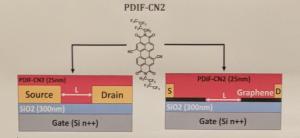Researchers from Italy's ISOF-CNR, University of Naples "Federico II" and Università di Modena e Reggio Emilia have developed new organic n-type FET transistors (OFETs) based on CVD graphene sheets. The researchers say that the new process and materials they used can enable flexible, transparent and short-channel OFETs - which could be used in the future for OLED or OLET (organic light emitting transistor) displays.

To create the new transistors, the researchers used thermally evaporated thin-films of PDIF-CN2 (a perylene diimide derivative) as the the organic semiconductor for the active channel of the transistor with the single-layer CVD graphene (grown at Italy's IIT institute) as the electrode material. The final device architectures have been fabricated via Electron-Beam-Lithography (EBL) and Reactive Ion Etching (RIE).
The researchers explain that these new OFETs take advantage of graphene's excellent mechanical, optical and electrical properties. Graphene is now closing the gap with more commonly used transparent electrode materials (such as ITO and other carbon-based alternatives) in terms of sheet resistance and transparency.
The next step for the research group is to realize high-frequency devices and achieve MHz operation for their graphene-based OFETs.

